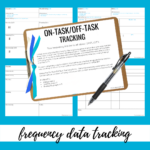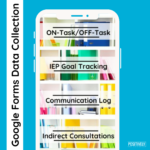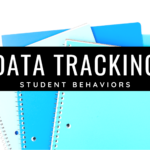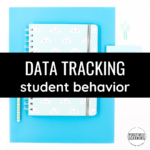
Whether you are in your first year as a special education teacher or a seasoned educator, perhaps one of the biggest struggles you will face is challenging student behaviors.
A quick Google search on “how to improve student behavior” will likely leave you more overwhelmed than before you started.
VIP student tables … table group awards … class reward systems … the list is a mile long of things we could do to try and correct student behavior.
But have you ever thought about taking a moment to really reflect on the behaviors themself?
One of the things I have found most useful when faced with a challenging student is using observation and tracking their behaviors throughout the day.
Here are a couple suggestions on how to do this …
Track when students express positive and negative behaviors throughout the day.
You may decide to break your day up by subject or by one hour time increments. Record when the student is most engaged in their learning and when they start to avoid tasks.
If you've ever heard (or maybe even said yourself), this behavior comes out of the blue! This recommendation is for you!
Record when the student is most engaged in their learning and when they start to avoid tasks. By tracking data this way, you may find the “triggers” for any off-task behavior and can more easily create a plan for how to improve it.
Track the frequency of 1-2 specific positive and negative behaviors.
If you already know what times of the day your student tends to do the best (pr, let's be honest – worst), then you might want to take a closer look at a few specific behaviors.
Taking a closer look at these trends could help you create a plan for supporting their positive choices moving forward.
My favorite (and the easiest) way to track behavior is simply frequency tracking.
This can be done on paper with quick tally marks. You will record the location and time of the observation and then all you will do is add a tally when a specific behavior is occurring. It's fast and the data speaks loudly – twenty tally marks during math vs. three during literacy? That speaks volumes (sorry Math!).
Frequency can also be recorded quickly digitally on your phone using Google Forms. This set of data collection forms makes it fast and easy to track the frequency of behaviors and then organize the collected information:
No matter how you decide to track the data, the ultimate goal is to reflect on what the information is telling you about the student. Are there things that can easily be put in place to help the student succeed or do they need more supports or interventions put into place?
Get started today with learning more about challenging student behavior!
Frequency trackers, data collection Google Forms, and so much more is located in one convenient place – check out the Special Educators Resource Room to put systems quickly into place!

I’m Jennifer and I was a special educator in the elementary school setting over the past decade. I entered the classroom every day dedicated to making learning inclusive AND engaging.





This website uses cookies to ensure you get the best experience on our website. See full disclosure here.
This website uses cookies to ensure you get the best experience on our website.
See full disclosure here.